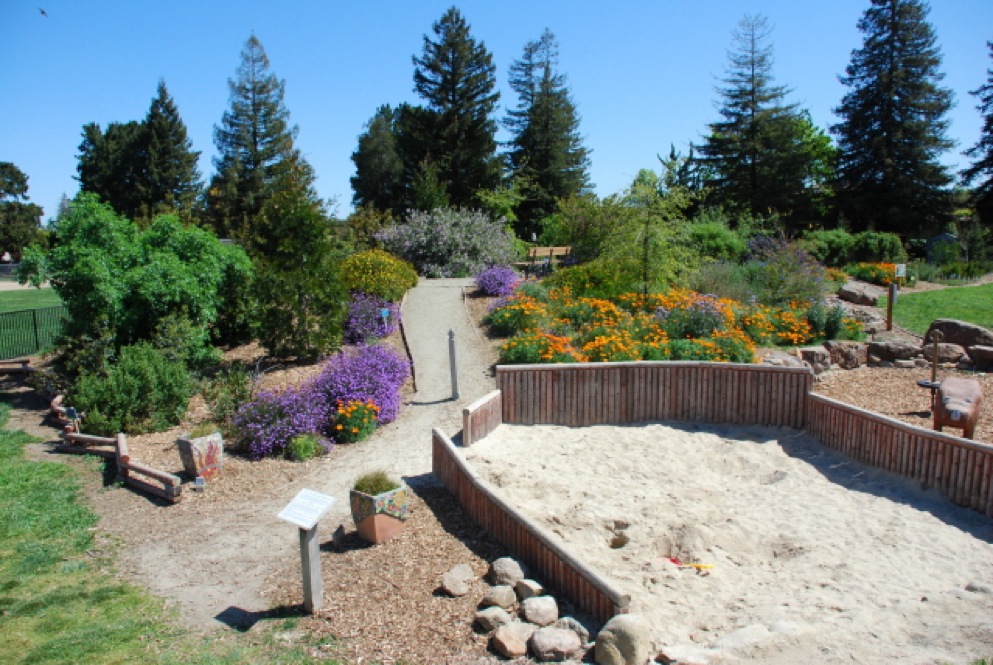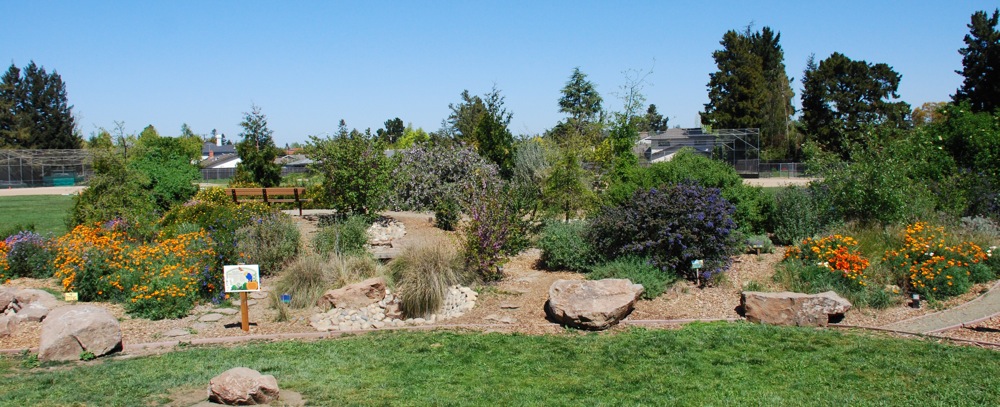Content Row
We are proud of our Native Habitat Garden at Oak School, and invite you to use it and care for it! For a full gallery of photos, click here.
Located adjacent to the baseball fields, the Garden offers a creative and natural setting for children’s play. It features a sand pit, a water pump, pathways, contoured hills, a range of plants, boulders to climb and sit on, and a mini-amphitheater/quiet reading area amongst a small redwood grove. Children can explore the paths, crawl into a cozy space under a bush, look for butterflies and insects, and more.
The garden is made up of almost exclusively California native plants, offering a snapshot of the wild California, before European and other plants were introduced and took over much of our landscape. The garden features plants commonly found in our oak woodland, redwood, grassland and chaparral plant communities and plants used by the Ohlone Indians. The garden includes over 70 plaques and plant stakes with information about all the plant species and their significance to California natural history. Exploring the garden offers the children to experience the plants and animals native to this area, the flowers, the scents of the plants, and more.
While the children can explore the Native Habitat Garden during recess time, we offer lunchtime programs to plant, monitor and maintain the garden and nestboxes, and more through the Nature Zone. Some Oak School teachers use the Garden to teach lessons on science, natural history, Native Americans, and more.
We expect, and hope, that this garden will inspire further creative ideas and projects on the Oak School campus, to provide greater educational, social, and aesthetic values to the school grounds.
In 2006, nesting boxes were placed around the campus as part of the California Bluebird Recovery Program. These nest boxes provide a place for the chestnut-backed chickadee, oak titmouse, Western bluebird and other birds to raise their young. Find out more about the birds at Oak and these nesting nesting boxes.
What is the Educational Benefit of the Garden?
During the past decade, thousands of schools have realized the enormous potential for transforming expanses of asphalt and grass into exciting natural spaces for learning, playing, and socializing. Through hands-on involvement in caring for and using school nature areas, children stand to improve their academic performance and to develop the willingness and capacity to work for the good of the human and natural communities of which they are a part. A diversity of habitats and features helps to meet students’ needs for exploration, imaginative play, and quiet reflection.
According to Delaine Eastin, former State Superintendent of Public Instruction, “A garden in every school is even more essential to make our standards come alive. We must not lose the creativity, problem solving, and sheer love of learning that comes from hands-on, experiential learning….Gardens should not compete with our standards; gardens should be an avenue to high standards.”
A 2002 survey showed that about 2,400 schools in California have gardens. Here’s why:
- Gardens integrate various disciplines and bring meaning to the standards for science, history, social science, mathematics, and English-language arts.
- Students with all levels of skills, varied learning styles, and diverse backgrounds can find a common interest in a school garden. Students who struggle in the classroom frequently find success in the school garden experience.
- Students learn responsibility and develop life skills through their work in gardens. They cooperate to finish a job and learn to respect the contributions of others. They have the opportunity to take pleasure in physical work.
- Gardens educate students to use their senses. They give children the opportunity to experience the natural world through sight, sound, smell, touch, and taste.
- Gardens connect students to the earth and ecological processes and provide them with empowering experiences as they explore environmental questions.
- Successful gardens strengthen school pride and identity. Older children can instruct younger children and interact in a way that is constructive to both.
The garden provides a full context in which to explore, connect, and expand concepts in the standards.
Another wonderful benefit of the Oak Garden is that it is immediately accessible—teachers do not need to transport their classes long distances in order to connect with nature. Wilderness experiences can be profound, but in most schools they last a few hours on a field trip or at most a week. Then students and teachers come back to the classroom and are at a loss for how to maintain their relationship with nature. School gardens make the relationship continuous, allowing children to see the changes that occur in a natural system from day to day and week to week. An interest in nature is one of the best gifts we can give to children, because wherever the child goes, he or she will find interest, awe, and comfort in the nature of the new place.
Thank you to all the families who donated towards the garden by sponsoring a tree and the redwood amphitheatre and the following businesses and individuals whose generous in-kind contributions made this garden possible:
Judy Schwarz of Landscape Designs by Judith, Middlebrook Gardens, Capitol Wholesale Nursery, Mountain View Garden Center, Valley Crest Tree Company, The Home Depot, Peninsula Building Materials, Lyngso Garden Materials, Los Altos Landscaping Company,
The Valley of Heart’s Delight Project, Foothill College Environmental Horticulture Department; Real Estate Solutions, Sam Vesuna--Scout Troop 37, Sue Welch of the California Native Grasslands Association, the California Native Plant Society, Acterra Native Plant Nursery, Orchard Supply Hardware, The Care of Trees.
NOT YET CHECKED
8/2/25 3:04 PM


